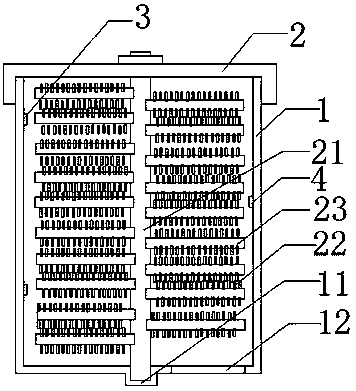Method for promoting angelica keiskei seed germination by stirring device
A technology of stirring device and stirring blade, which is applied to mixers with rotary stirring devices, accessories of mixers, seed and rhizome treatment, etc. Mold and rot problems, to achieve the effect of neat germination, shorten the germination period, and improve the germination rate
- Summary
- Abstract
- Description
- Claims
- Application Information
AI Technical Summary
Problems solved by technology
Method used
Image
Examples
Embodiment 1
[0019] A method for promoting the germination of Ashitaba seeds by using a stirring device, comprising the following steps:
[0020] (1) The ashitaba seeds are treated in a far-infrared device at a temperature of 58°C for 20 seconds and set aside;
[0021] (2) Prepare a mixed solution, which is obtained by mixing biogas slurry and chitosan aqueous solution with a mass concentration of 10% at a weight ratio of 5:1;
[0022] (3) Mix the mixture with the seeds at a volume ratio of 1.5:1, add it into the tank, ensure that the lid and the discharge port are closed, start the heating device, make the temperature of the mixture reach 30°C, start the rotating shaft, and continue to heat the mixture Stop heating when the temperature is 38°C, keep the temperature at 34-38°C, stir at 120 rpm for 14 minutes, and discharge from the outlet after completion;
[0023] (4) After the seeds treated by the stirring device are drained, they are dried at a temperature of 60°C, and the seedlings ca...
Embodiment 2
[0028] A method for promoting the germination of Ashitaba seeds by using a stirring device, comprising the following steps:
[0029] (1) The ashitaba seeds are treated in a far-infrared device at a temperature of 55°C for 25 seconds and set aside;
[0030] (2) Prepare a mixed solution, which is obtained by mixing biogas slurry and chitosan aqueous solution with a mass concentration of 8% at a weight ratio of 6:1;
[0031] (3) Mix the mixed liquid with the seeds at a volume ratio of 1.4:1, add it into the tank, and ensure that the lid and the discharge port are closed, then start the heating device to make the temperature of the mixed liquid reach 30°C, then start the rotating shaft, and continue to heat the mixed liquid When the temperature reaches 38°C, stop heating, keep the temperature at 34-38°C, and stir at 100 rpm for 12 minutes. After completion, discharge from the discharge port;
[0032] (4) After the seeds treated by the stirring device are drained, they are dried a...
Embodiment 3
[0035] A method for promoting the germination of Ashitaba seeds by using a stirring device, comprising the following steps:
[0036] (1) The ashitaba seeds are treated in a far-infrared device at a temperature of 60°C for 15 seconds and set aside;
[0037] (2) Prepare a mixed solution, which is obtained by mixing biogas slurry and chitosan aqueous solution with a mass concentration of 12% at a weight ratio of 4:1;
[0038] (3) Mix the mixture with the seeds at a volume ratio of 1.6:1, add it into the tank, ensure that the lid and the discharge port are closed, and start the heating device to make the temperature of the mixture reach 30°C, then start the rotating shaft, and continue to heat the mixture Stop heating when the temperature is 38°C, keep the temperature at 34-38°C, stir at 140 rpm for 16 minutes, and discharge from the discharge port after completion;
[0039] (4) After the seeds treated by the stirring device are drained, they are dried at a temperature of 55°C, a...
PUM
| Property | Measurement | Unit |
|---|---|---|
| Length | aaaaa | aaaaa |
| Length | aaaaa | aaaaa |
| Length | aaaaa | aaaaa |
Abstract
Description
Claims
Application Information
 Login to View More
Login to View More - R&D
- Intellectual Property
- Life Sciences
- Materials
- Tech Scout
- Unparalleled Data Quality
- Higher Quality Content
- 60% Fewer Hallucinations
Browse by: Latest US Patents, China's latest patents, Technical Efficacy Thesaurus, Application Domain, Technology Topic, Popular Technical Reports.
© 2025 PatSnap. All rights reserved.Legal|Privacy policy|Modern Slavery Act Transparency Statement|Sitemap|About US| Contact US: help@patsnap.com

